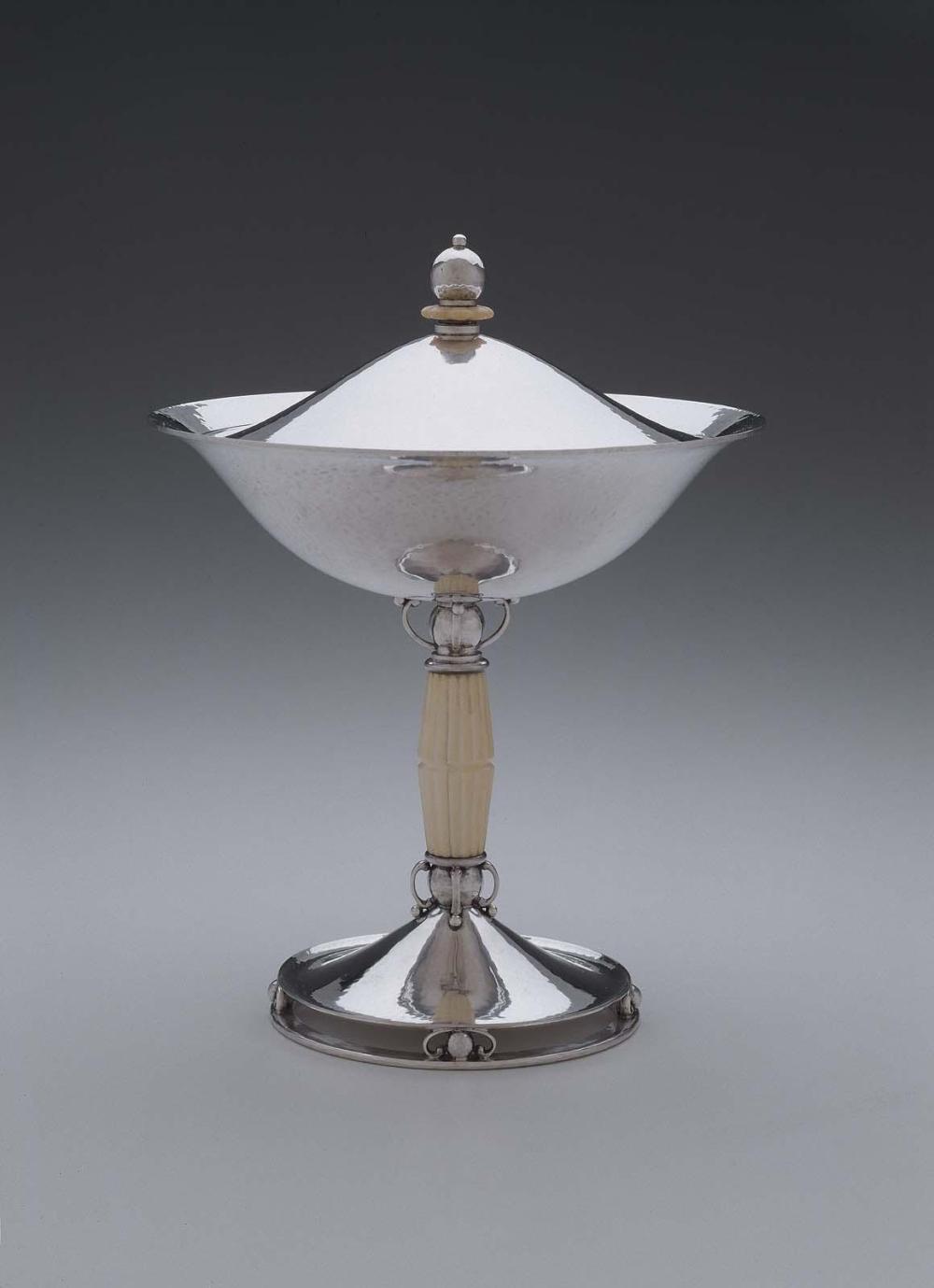Advanced Search
Candy dish
Designed by: Erik Magnussen (Danish (active in the United States), 1884–1961)
For: Gorham Manufacturing Company (active 1865–1961)
For: Gorham Manufacturing Company (active 1865–1961)
designed 1926
Object Place: Providence, Rhode Island, United States
Medium/Technique
Silver, ivory
Dimensions
Overall: 17.9 cm, 0.7 kg (7 1/16 in., 1.6 lb.); Diam (Height x diameter: includes lid): 16.6cm (6 9/16in.)
Credit Line
The John Axelrod Collection
Accession Number1999.254a-b
NOT ON VIEW
ClassificationsSilver hollowware
Born in Copenhagen, Erik Magnussen was a product of the cultural Danish scene and a contemporary of Georg Jensen (1866 – 1935). From 1898 to 1901, Magnussen worked at Winkel and Magnussen, an art gallery run by his uncle, while studying sculpture with Stephan Sinding (1846 – 1922) and chasing with silversmith Viggo Hansen. By 1907 Magnussen had relocated to Berlin, where for two years he worked as a chaser in the workshop of Otto Rohloff at the Kunstgewerbeschule. In 1909 the artist returned to Copenhagen, where he opened his own studio. Soon thereafter, he began to exhibit his work both locally and more widely with shows in Berlin (1910, 1911), Paris (1922), and Rio de Janeiro (1922).
In 1924 Georg Jensen established the company’s first American showroom in New York City. Its success apparently prompted American firms to follow popular interest in Scandinavian-style silver designs. The next year, Gorham Manufacturing Company of Providence, Rhode Island, hired Magnussen as art director, thus heralding a major change in their product line. This candy dish, designed shortly after his arrival in 1926, owes a stylistic debt to Jensen, as is evident in the double foot rim, stylized plant motifs, and glimmering planished surface. The reeded ivory column provides a Neoclassical reference that Magnussen reprised in later works, such as the Modern American series (cat. no. 341). The inscription is dated 1936, ten years after the design was introduced, suggesting that the candy dish continued in popularity or that it was leftover stock.
This text has been adapted from "Silver of the Americas, 1600-2000," edited by Jeannine Falino and Gerald W.R. Ward, published in 2008 by the MFA. Complete references can be found in that publication.
In 1924 Georg Jensen established the company’s first American showroom in New York City. Its success apparently prompted American firms to follow popular interest in Scandinavian-style silver designs. The next year, Gorham Manufacturing Company of Providence, Rhode Island, hired Magnussen as art director, thus heralding a major change in their product line. This candy dish, designed shortly after his arrival in 1926, owes a stylistic debt to Jensen, as is evident in the double foot rim, stylized plant motifs, and glimmering planished surface. The reeded ivory column provides a Neoclassical reference that Magnussen reprised in later works, such as the Modern American series (cat. no. 341). The inscription is dated 1936, ten years after the design was introduced, suggesting that the candy dish continued in popularity or that it was leftover stock.
This text has been adapted from "Silver of the Americas, 1600-2000," edited by Jeannine Falino and Gerald W.R. Ward, published in 2008 by the MFA. Complete references can be found in that publication.
DescriptionThe tall vessel has a raised cup with a wide, flaring rim and an applied bezel setting to receive lid. The lid is supported by a column-like, fluted ivory stem with spherical and foliate decoration at each end. A spreading circular foot flares slightly upward at edge. The entire cup is raised upwards by a foot ring with similar sphere and foliate brackets. A bell-shaped lid, with a spherical silver finial and floral ivory insert, echoes the form of bowl.
Marks
Sequential, incuse touchmarks "GORHAM" in roman letters; lion passant, anchor, and Gothic letter "G" each in a shaped device; "STERLING" in sans serif lettering; F / Y N; and a [sailboat = 1926 date letter] are stamped underneath ring foot.
InscriptionsEngraved " * EVERETT AND EVA BACON * 1936* in roman letters underneath ring Foot.
ProvenanceBy 1985, with Historical Design, Inc., New York, New York; July 27,1985, purchased through trade from Historical Design (Denis Gallion and Daniel Morris) by John Axelrod, Boston, MA; 1999, gife of Axelrod to the MFA



